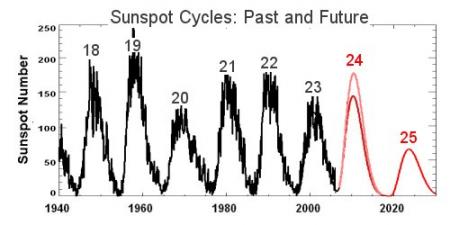Well, I was just talking to a fellow Ham Radio Operators and I had mentioned that this year my solar system isn't producing as much as last year. Last year I was generating an average of high 40k's and a few 50k's and this year Im stuck in around the low to mid 30k's... He mentioned that we are now leaving Solar Cycle 24 and now entering Solar Cycle 25.
The following is some info and links on this type of info:
Solar Cycle 24 begin on Jan 10, 2008 and it was starting to hit the low peaks of Solar Flares and Sun Spot activities etc.
Solar activity waxes and wanes in 11-year cycles. Lately, we've been experiencing the low ebb, "very few flares, sunspots, or activity of any kind," says Hathaway. "Solar minimum is upon us."Solar Cycle 24:
http://science.nasa.gov/headlines/y2008 ... ycle24.htmSolar minimum and solar maximumSolar minimums and maximums are the two extremes of the sun's 11-year activity cycle. At a maximum, the sun is peppered with sunspots, solar flares erupt, and the sun hurls billion-ton clouds of electrified gas into space. It's a good time for sky watchers who enjoy auroras, but not so good for astronauts who have to be wary of radiation storms. Power outages, satellite function and communication disruptions, and GPS receiver malfunctions are just a few of the things that can happen during a solar max.
At a solar minimum, there are fewer sunspots and solar flares subside. Sometimes, days or weeks go by without a spot. It is a safer time to travel through space, but a less interesting time to watch polar skies.
Characteristics of solar minimumSolar minimum is characterized by a period of minimum solar activity with few, if any, sunspots. Generally, this is the safest time for astronauts to do their missions due to an associated decrease in solar radiation. During solar minimum, scientists can predict the next two solar cycles using the solar "conveyor belt." If the conveyor belt is moving rapidly it will sweep up lots of old magnetic fields on the sun's surface to the sun's center, eventually returning to the surface as lots of new sunspots. The opposite is true when the conveyor belt is moving slowly since fewer old magnetic fields are being swept down. Using this method of forecasting, Solar Cycle 25 will be a very mild cycle with few sunspots even during solar maximum.
http://en.wikipedia.org/wiki/Solar_minimumHeres a diagram of Sun Spot activities, as you can see it starts to taper off around 2008:
 Solar Cycles
Solar Cycles:
http://en.wikipedia.org/wiki/Sunspot_cycleThe slowdown we see now means that Solar Cycle 25, peaking around the year 2022, could be one of the weakest in centuries.
 Solar Cycle 25 peaking around 2022 could be one of the weakest in centurieshttp://www.physorg.com/news66581392.html
Solar Cycle 25 peaking around 2022 could be one of the weakest in centurieshttp://www.physorg.com/news66581392.html




